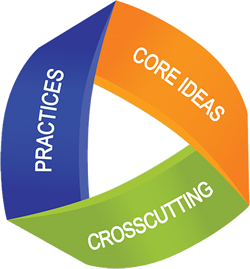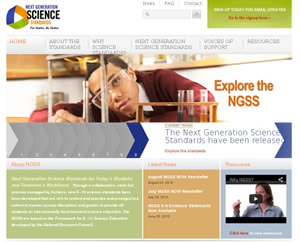Next Generation Science Standards
Quick Reference
Disciplinary Core Ideas
LS1A - Structure and Function
LS1B - Growth and development
LS1C - Organization for Matter (Energy)
LS1D - Information Processing
LS2A - Interdependent Relationships (Ecosystems)
LS2B - Cycles of Matter and Energy
LS2C - Ecosystem Dynamics
LS2D - Social Interactions and Group Behavior
LS3A - Inheritance of Traits
LS3B - Variation of Traits
LS4A - Evidence of Common Ancestry
LS4B - Natural Selection
LS4C - Adaptation
LS4D - Biodiversity and Humans
HS-LS1 From Molecules to Organisms: Structures and Processes
HS-LS1-1 Construct an explanation based on evidence for how the structure of DNA determines the structure of proteins which carry out the essential functions of life through systems of specialized cells
HS-LS1-2 Develop and use a model to illustrate the hierarchical organization of interacting systems that provide specific functions within multicellular organisms
HS-LS1-3 Plan and conduct an investigation to provide evidence that feedback mechanisms maintain homeostasis.
Examples of investigations could include heart rate response to exercise, stomate response to moisture and temperature, and root development in response to water levels.] [Assessment Boundary: Assessment does not include the cellular processes involved in the feedback mechanism.
HS-LS1-4 Use a model to illustrate the role of cellular division (mitosis) and differentiation in producing and maintaining complex organisms.
HS-LS1-5 Use a model to illustrate how photosynthesis transforms light energy into stored chemical energy.
HS-LS1-6 Construct and revise an explanation based on evidence for how carbon, hydrogen, and oxygen from sugar molecules may combine with other elements to form amino acids and/or other large carbon-based molecules.
HS-LS1-7 Use a model to illustrate that cellular respiration is a chemical process whereby the bonds of food molecules and oxygen molecules are broken and the bonds in new compounds are formed resulting in a net transfer of energy.

HS-LS2 Ecosystems: Interactions, Energy, and Dynamics
HS-LS2-1 Use mathematical and/or computational representations to support explanations of factors that affect carrying capacity of ecosystems at different scales.
HS-LS2-2 Use mathematical representations to support and revise explanations based on evidence about factors affecting biodiversity and populations in ecosystems of different scales.
HS-LS2-3 Construct and revise an explanation based on evidence for the cycling of matter and flow of energy in aerobic and anaerobic conditions.
HS-LS2-4 Use mathematical representations to support claims for the cycling of matter and flow of energy among organisms in an ecosystem
HS-LS2-5 Develop a model to illustrate the role of photosynthesis and cellular respiration in the cycling of carbon among the biosphere, atmosphere, hydrosphere, and geosphere
HS-LS2-6 Evaluate the claims, evidence, and reasoning that the complex interactions in ecosystems maintain relatively consistent numbers and types of organisms in stable conditions, but changing conditions may result in a new ecosystem
HS-LS2-7 Design, evaluate, and refine a solution for reducing the impacts of human activities on the environment and biodiversity.*
HS-LS2-8 Evaluate the evidence for the role of group behavior on individual and species’ chances to survive and reproduce.
HS-LS3 Heredity: Inheritance and Variation of Traits
HS-LS3-1 Ask questions to clarify relationships about the role of DNA and chromosomes in coding the instructions for characteristic traits passed from parents to offspring
HS-LS3-2 Make and defend a claim based on evidence that inheritable genetic variations may result from: (1) new genetic combinations through meiosis, (2) viable errors occurring during replication, and/or (3) mutations caused by environmental factors
HS-LS3-3 Apply concepts of statistics and probability to explain the variation and distribution of expressed traits in a population
HS-LS4 Biological Evolution: Unity and Diversity
HS-LS4-1 Communicate scientific information that common ancestry and biological evolution are supported by multiple lines of empirical evidence
HS- LS4-2 Construct an explanation based on evidence that the process of evolution primarily results from four factors: (1) the potential for a species to increase in number, (2) the heritable genetic variation of individuals in a species due to mutation and sexual reproduction, (3) competition for limited resources, and (4) the proliferation of those organisms that are better able to survive and reproduce in the environment
HS-LS4-3 - Apply concepts of statistics and probability to support explanations that organisms with an advantageous heritable trait tend to increase in proportion to organisms lacking this trait.
HS-LS4-4 - Construct an explanation based on evidence for how natural selection leads to adaptation of populations.
HS-LS4-5 Evaluate the evidence supporting claims that changes in environmental conditions may result in: (1) increases in the number of individuals of some species, (2) the emergence of new species over time, and (3) the extinction of other species.
HS-LS4-6 Create or revise a simulation to test a solution to mitigate adverse impacts of human activity on biodiversity.*
8 Practices of Science and Engineering
1. Asking questions (for science) and defining problems (for engineering)
2. Developing and using models
3. Planning and carrying out investigations
4. Analyzing and interpreting data
5. Using mathematics and computational thinking
6. Constructing explanations (for science) and designing solutions (for engineering)
7. Engaging in argument from evidence
8. Obtaining, evaluating, and communicating information
